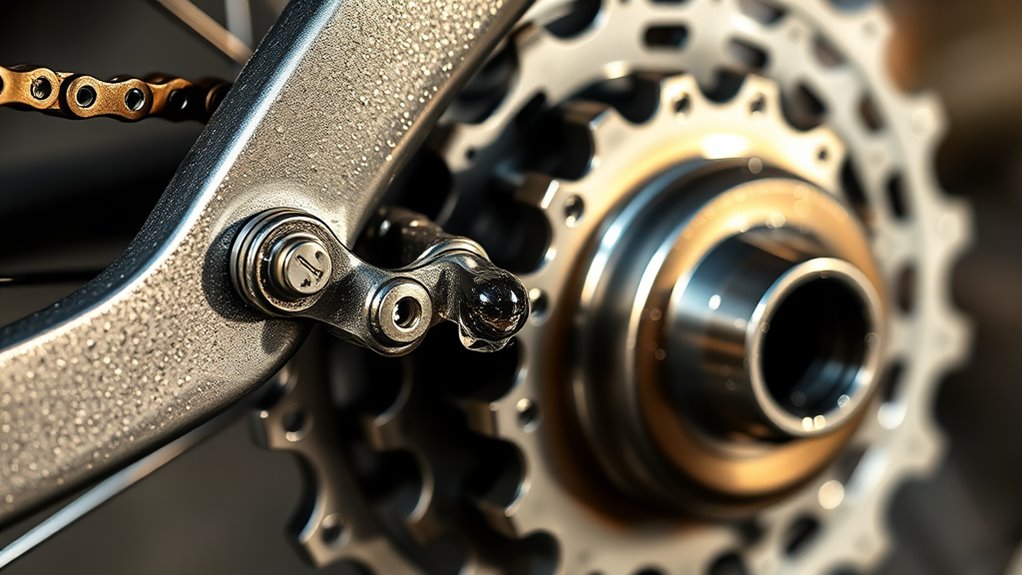Most people overlook that harsh cleaners can damage your drivetrain’s protective lubricants, and scrubbing too hard can misalign gears. Using the right biodegradable degreaser, soft brushes, and microfiber cloths is vital for a thorough clean without harm. Proper technique, including soaking the chain and applying just enough lubricant, prevents issues like over-lubrication. To extend component life and avoid costly repairs, it’s essential to follow these tips—you’ll discover more secrets if you keep going.
Key Takeaways
- Over-cleaning or using harsh chemicals can strip essential lubricants, causing more wear on drivetrain parts.
- Proper gear alignment is often overlooked but crucial for smooth shifting and long-term component health.
- Applying too much lubricant can attract dirt, leading to faster grime buildup and decreased performance.
- Regular inspection and proactive replacement of worn chains prevent damage to cassette and derailleur.
- Using the right cleaning tools, like soft brushes and microfiber cloths, helps prevent damage to sensitive components.
Common Mistakes That Can Damage Your Drivetrain
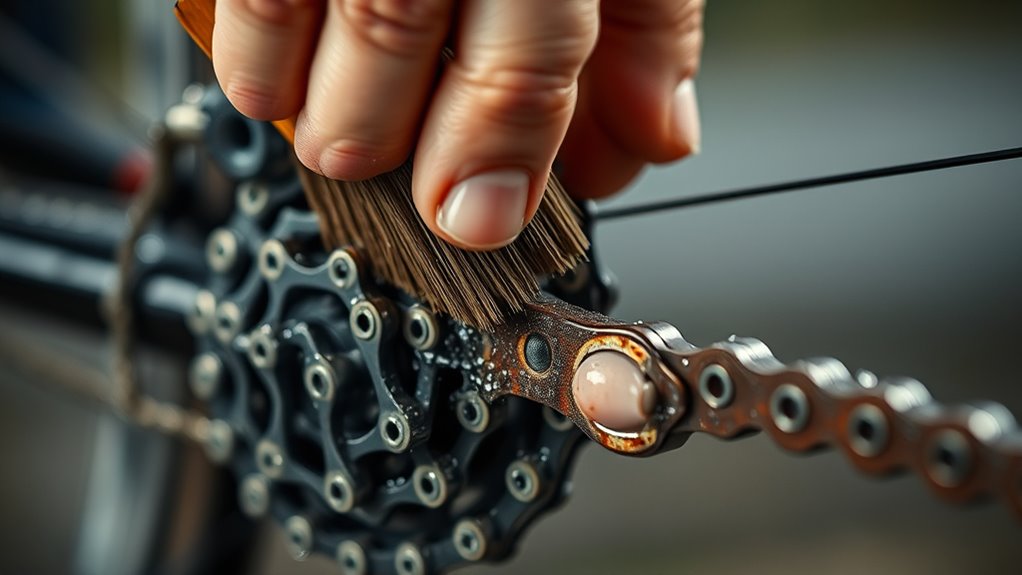
One of the most common mistakes that can damage your drivetrain is using harsh or abrasive cleaners. These substances can strip away protective lubricants, accelerating chain wear and causing components to deteriorate faster. When cleaning, it’s tempting to scrub vigorously, but this can disturb gear alignment, leading to poor shifting and increased wear. Misaligned gears put extra stress on the chain, increasing the risk of skipping or breaking. Instead, opt for gentle cleaning methods, focusing on removing debris without damaging the chain or gears. Neglecting proper cleaning can also cause dirt and grime to build up, further compromising gear alignment and accelerating wear. Regular maintenance practices help prevent buildup and preserve drivetrain health. Being mindful of your cleaning techniques helps preserve your drivetrain’s longevity and smooth performance.
The Right Products and Tools for Effective Cleaning
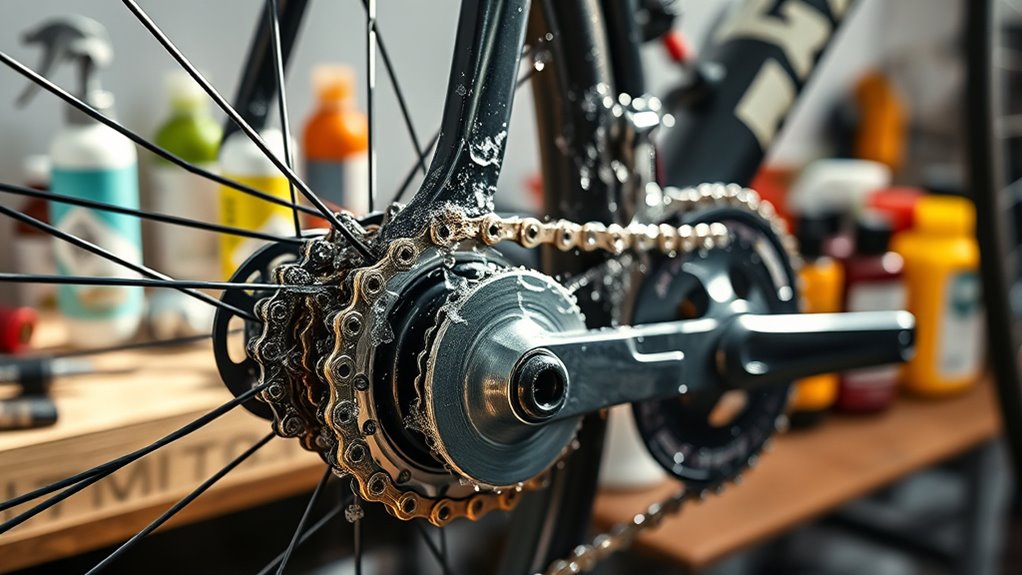
Choosing the right products and tools is essential for effectively cleaning your drivetrain without causing damage. Using suitable cleaning solutions and degreasing products guarantees you break down grease and grime efficiently without harming components. Invest in quality brushes, rags, and a spray bottle to apply cleaning agents accurately. Look for biodegradable and bike-specific degreasing products that are gentle yet effective. Avoid harsh chemicals that can damage seals or paint. Here’s what you’ll need:
- Bike-specific degreasing products
- Soft-bristled brushes for delicate parts
- Microfiber cloths for wiping and polishing
- Spray bottles for even application
- Proper cleaning techniques help ensure thorough removal of dirt without risking damage to sensitive parts.
Step-by-Step Technique for a Thorough Clean
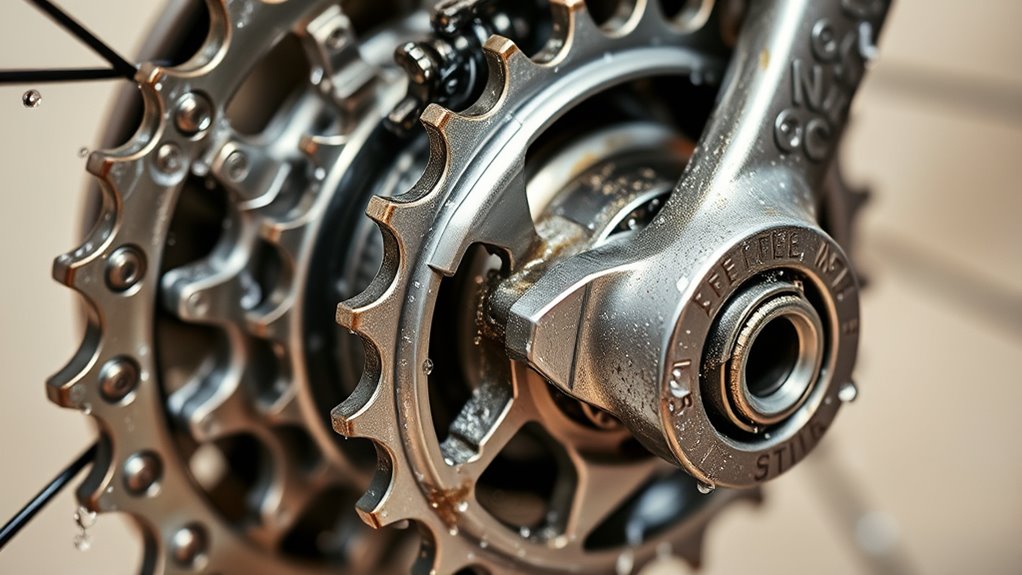
To guarantee your drivetrain is thoroughly cleaned, follow a systematic approach that targets each component carefully. Start by removing the chain and soaking it in a degreaser, then scrub with a brush to remove built-up grime. While the chain dries, inspect gear alignment and clean the cassette and derailleur with a brush and rag, ensuring no debris hinders shifting. Use a chain cleaning tool or brush to remove dirt from between the links, then re-lubricate properly. Check the gear alignment afterward, adjusting if necessary to ensure smooth shifting. Proper chain maintenance prevents premature wear, while correct gear alignment ensures efficient power transfer. Following this step-by-step process guarantees a clean, well-functioning drivetrain that performs reliably and lasts longer. Additionally, maintaining awareness of AI security vulnerabilities can help ensure that your bike’s electronic components remain safe from cyber threats.
When to Lubricate and How to Avoid Over-lubrication
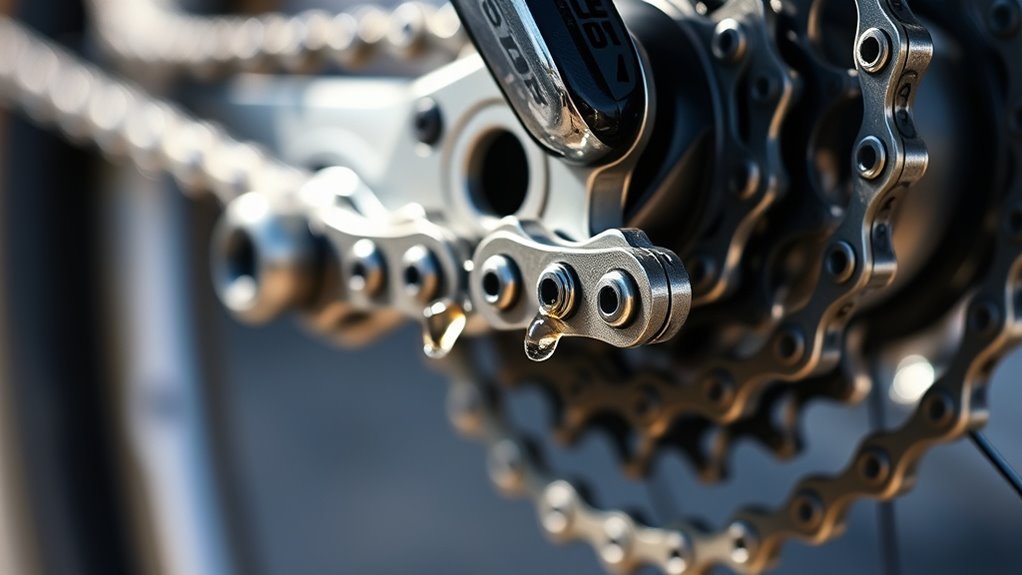
After thoroughly cleaning your drivetrain components, it’s time to determine the right moment to apply lubricant. Proper lubrication frequency ensures smooth operation without attracting dirt or causing excess buildup. To avoid excess lubrication, follow these tips:
- Apply a small amount, focusing on chain links and sprockets
- Wipe off any visible excess immediately
- Let the lubricant set for a few minutes before riding
- Reassess and reapply only if you notice squeaking or stiffness
- Remember that color accuracy in your drivetrain components can impact overall performance and longevity.
Maintenance Tips to Extend the Life of Your Components
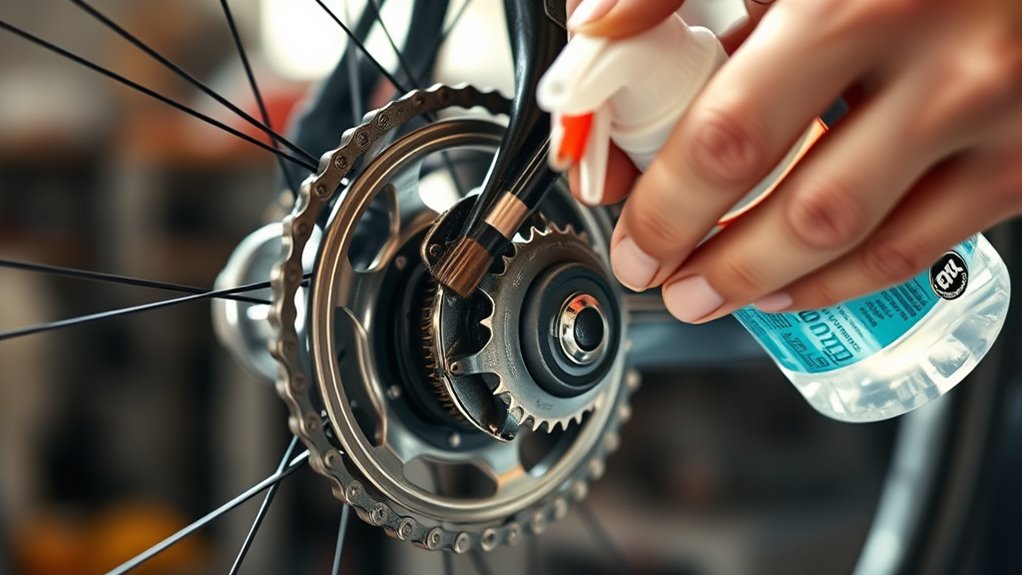
Regularly inspecting your drivetrain components and addressing issues promptly can considerably extend their lifespan. Focus on chain preservation by checking for wear and replacing it before it causes damage to other parts. Conduct drivetrain inspections after rides to spot signs of rust, dirt buildup, or stretched links. Keeping your chain clean and well-lubricated reduces friction and prevents premature wear. Avoid neglecting minor issues, as they can escalate into costly repairs. Proper maintenance also involves ensuring your derailleur and cassette are free of debris and functioning smoothly. By staying proactive with regular inspections and cleaning, you’ll minimize component fatigue and prolong the life of your entire drive train. Consistent care not only enhances performance but saves you money in the long run. Additionally, adopting data-driven strategies can help you identify patterns of wear and optimize your maintenance schedule for better results.
Frequently Asked Questions
How Often Should I Clean My Drivetrain for Optimal Performance?
You should clean your drivetrain every 100-200 miles or when you notice chain squeaking or grit. During cleaning, focus on removing dirt and old chain lubrication, which can affect gear alignment and shifting. After cleaning, re-lubricate your chain properly. Regular maintenance keeps your gears running smoothly, prolongs component life, and guarantees ideal performance. Don’t forget to check gear alignment periodically to prevent unnecessary wear and tear.
Can I Use Household Cleaning Products on My Bike’s Drivetrain?
You shouldn’t use household cleaners on your bike’s drivetrain because they can damage components or leave harmful residues. For DIY maintenance, stick to bike-specific degreasers and lubricants, which are formulated for your drivetrain’s materials. Using household cleaners might seem convenient, but they often lack the proper cleaning power or safety for bike parts. Keep your drivetrain in top shape by choosing proper cleaning products designed for cycling.
Is It Necessary to Remove the Cassette Before Cleaning?
Think of your cassette as the heart of your drivetrain. Removing the cassette isn’t always necessary, but it makes thorough cleaning easier. With proper tools, you can tackle stubborn grime using cleaning techniques like brushing and degreasing without removal. However, for deep cleaning, cassette removal guarantees you get into every nook and cranny, extending your drivetrain’s lifespan and maintaining smooth shifting. Decide based on how dirty your cassette is and your cleaning goals.
What Are Common Signs Indicating My Drivetrain Needs Professional Repair?
If you notice your chain has significant wear or you’re experiencing shifting issues like slipping or hesitation, it’s time to seek professional repair. Chain wear can cause poor shifting and faster drivetrain damage, while persistent shifting problems often indicate worn or damaged components. Don’t ignore these signs, as timely expert help can prevent costly repairs and keep your bike running smoothly. Regular maintenance also helps identify issues early.
How Can I Prevent Rust and Corrosion After Cleaning?
Sure, because nothing screams fun like fighting rust after a clean, right? To prevent rust and corrosion, you should apply a quality corrosion protection spray or lubricant immediately after cleaning. Keep the drivetrain dry and store your bike in a dry place. Regularly inspect for moisture or dirt buildup, and reapply protective coatings as needed. This way, your drive-train stays smooth and rust-free, even in the most humid conditions.
Conclusion
Now, as you finish cleaning your drivetrain, you might notice how a simple routine saves you money and hassle. It’s funny how a little extra care can unexpectedly boost your ride’s performance, almost like the bike’s thanking you. Keep practicing these tips, and you’ll find that maintaining your drivetrain becomes second nature—just like those perfect rides when everything clicks. Sometimes, the smallest effort makes the biggest difference, and your bike will thank you for it.
